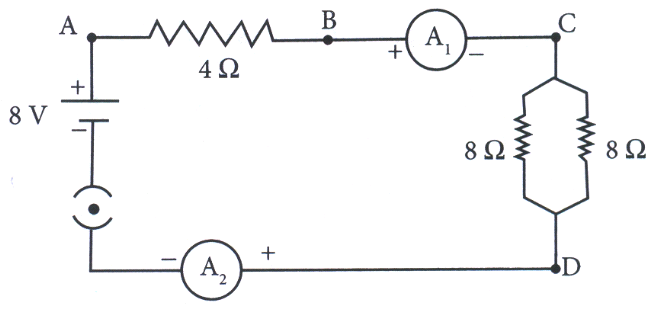CBSE 10th Standard Science Subject Electricity Ncert Exemplar 5 Mark Questions 2021
By QB365 on 26 May, 2021
QB365 Provides the updated NCERT Exemplar Questions for Class
10, and also provide the detail solution for each and every NCERT Exemplar questions. NCERT Exemplar questions are latest updated question pattern from NCERT, QB365 will helps to get more marks in Exams
QB365 - Question Bank Software
CBSE 10th Standard Science Subject Electricity Ncert Exemplar 5 Mark Questions 2021
10th Standard CBSE
-
Reg.No. :
Science
-
State Ohm's law? How can it be verified experimentally? Does it hold good under all conditions? Comment
(a) -
How will you infer with the help of an experiment that the same current flows through every part of the circuit containing three resistances in series connected to a battery?
(a) -
How will you conclude that the same potential difference exist across three resistors connected in a parallel arrangement to a battery?
(a) -
Find out the following in the electric circuit given in figure
(a) Effective resistance of two 8\(\Omega\) resistors in the combination
(b) Current flowing through 4\(\Omega\) resistor.
(c) Potential difference across 4\(\Omega\) resistance
(d) Power dissipated in 4\(\Omega\) resistor.
(e) Difference in ammeter readings, if any.(a) -
Find out the following in the electric circuit given in Figure
(a) Effective resistance of two 8 \(\Omega\) resistors in the combination
(b)Current flowing through 4 \(\Omega\) resistor
(c) Potential difference across 8 \(\Omega\) resistance
(d) Power dissipated in 4 \(\Omega\) resistor
(e) Difference in ammeter readings, if any.
 (a)
(a)
*****************************************
CBSE 10th Standard Science Subject Electricity Ncert Exemplar 5 Mark Questions 2021 Answer Keys
-
At constant temperature, the current flowing through a conductor is directly proportional to the potential difference across its ends.
Onh's law does not hold good under all conditions as it is not a fundamental law of nature like Newton's laws. It is obeyed by metallic conductors only when physical condition like temperature etc., are kept unchanged. It is not obeyed by a lamp filament. -
A number of resistors are said to be connected in series, if these are joined end to end and the same, current flows through each one of them when a potential difference is applied across the combination. If we connect ammeter first between the point A and R1, then between R1 and R2:R2 and R3 and lastly between R3 and the point B; it is same as current.
-
A number of resistors are said to be connected in parallel if one end of each is connected to one point and the other end is connected to another point so that the potantial difference across each resistor is the same and is equal to the applied potential difference between the two points. If we connect a voltmeter first across R1, then across R2 ad lastly across R3, it will show same voltage.
-
(a) Since two 8\(\Omega\) resistors are in parallel, their effective resistance \((R_{ p })\) is given
by,\(\frac { 1 }{ R_{ p } } =\frac { 1 }{ 8 } +\frac { 1 }{ 8 } +\frac { 1 }{ 4 } or\quad R_{ p }=4\Omega \)
(b) Total resistance in the circuit \(R=4\Omega +R_{ p }=4\Omega +4\Omega =8\Omega \) Current through the electric circuit
\(I=\frac { V }{ R } =\frac { 8V }{ 8\Omega } =1A\)
(c) The potential difference 4\(\Omega\) resistor V\(=IR=1\times 4=4V\)
(d) Power dissipated in 4 \(\Omega\) resistor \(P={ I }^{ 2 }\) \(R=({ 1) }^{ 2 }(4)=4W\)
(e) There is no difference in the readings of ammeters \({ A }_{ 1 }\) and \({ A }_{ 1 }\) as same current flows through all elements in a series circuit. -
(a) Since two \(8\Omega \) resistors are in parallel, their effective resistance (\({ R }_{ P }\)) is given by,
\(\frac { 1 }{ { R }_{ P } } =\frac { 1 }{ 8 } +\frac { 1 }{ 8 } +\frac { 1 }{ 4 } \) or \({ R }_{ P }=4\Omega \)
(b) Total resistance in the circuit
\(R=4\Omega +{ R }_{ P }=4\Omega +4\Omega =84\Omega \)
Current through the electric circuit
\(I=\frac { V }{ R } =\frac { 8V }{ 8\Omega } =1A\)
(c) The potential difference \(4\Omega \) resistor V
I \(=IR=1\times 4=4V\)
(d) Power dissipated in \(4\Omega \) resistor P=\({ (I) }^{ 2 }\)
\(R={ (1) }^{ 2 }(4)=4W\)
(e) There is no difference in the readings of ammeters \({ A }_{ 1 }\) and \({ A }_{ 2 }\) as same current flows through all elements in a series circuit.

























